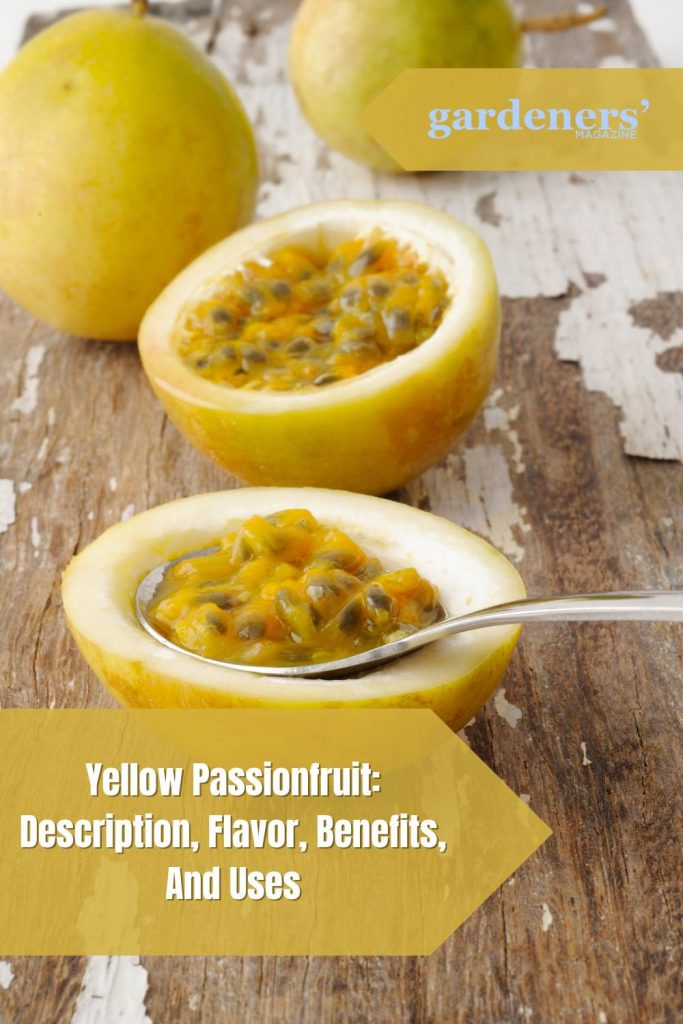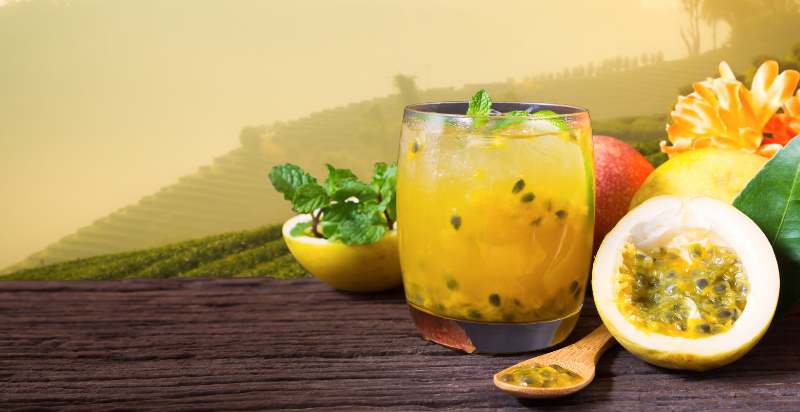Yellow Passionfruit (Passiflora edulis Sims) is a tropical fruit enjoyed for centuries worldwide. It grows on a vine and has an oval-shaped exterior with yellow, juicy flesh inside. The passionfruit flavor is sweet yet tangy, making it a popular addition to many dishes. Passionfruit is rich in vitamins, minerals, and other essential nutrients, providing numerous health benefits. It can be consumed fresh, used in recipes or juices, and even dried to extend its shelf life. Here is a look at what makes this fruit special and why it should be part of your diet.
What is Yellow Passionfruit?
Yellow Passionfruit is native to South America and is a member of the Passiflora family. It has an oval-shaped exterior with a yellow, succulent interior. When ripe, the fruit has an orange or yellow color, and its texture varies from firm to juicy depending on how ripe it is. The flavor is sweet yet tangy, making it a popular addition to many dishes.

History and Origin of Yellow Passionfruit:
The origin of yellow passionfruit is believed to be in South America. It is native to Brazil, Paraguay, Uruguay, and Argentina, with wild populations in many countries. The species was introduced into Hawaii by Portuguese settlers in the early 1800s and subsequently spread across tropical areas worldwide, becoming an important commercial crop today.
Passionfruit has an intense flavor and aroma that is very popular in cuisine worldwide. In its native range, it is used to make refreshing drinks, desserts, sauces, and jams. It also has a variety of medicinal uses. For example, Brazilian natives use passionfruit juice for coughs and colds, while some Indigenous communities have traditionally rubbed passionfruit pulp onto wounds or ingested it as an antiparasitic treatment. This is grown commercially in numerous tropical countries, including Australia, India, and Southeast Asia. It is also widely available in grocery stores, usually sold as whole fruits or juice.
Description of the Yellow Passionfruit:
The Yellow Passionfruit (Passiflora edulis) is typically oval-shaped, about 5-7 cm long and 4-5 cm wide. Its bright yellow skin may be covered in small brown spots or blisters. When ripe, it becomes slightly soft and fragrant. It has yellow, juicy flesh with an abundance of edible, black seeds (or “arils”) embedded in it.
The flavor of the this Passionfruit is sweet and juicy, with a hint of tartness. It can be eaten raw or used to make jams, jellies, juices, smoothies, ice cream, and more. Its seeds are also edible and add an interesting crunchy texture to recipes. Additionally, its leaves are often steeped as tea for their calming effects. Yellow Passionfruit is a healthy, versatile fruit that can be enjoyed in various ways.

Flavor Profile of the Yellow Passionfruit:
The Yellow Passionfruit is a unique and distinctive fruit. It has a sweet, tart flavor with hints of citrus and tropical fruits. The texture is soft and juicy with a slightly acidic aftertaste. Its aroma is exotic, fragrant, and tropical. The pulp contains small edible seeds that can add crunchiness to various dishes. In some cultures, it is also used for medicinal purposes due to its high levels of antioxidants and vitamins.
Cultivation of the Yellow Passionfruit:
The Yellow Passionfruit is a tropical climber requiring warm temperatures for successful growth. It is best grown in well-drained, fertile soil with good organic matter content. The ideal pH range for growing this plant is 6-7.5, with 7 being the optimum. The plant should be provided with 30-40 cm of mulch for optimal growth to keep the soil moist and cool.
It is best to plant the Yellow Passionfruit in full sun, although it can tolerate partial shade. The vines should be 2-4 meters apart, with 4 meters being preferable for increased production. They can also be trained to grow on trellises, poles, or arbors for easier harvesting and improved air circulation.
To maximize yield, the top of the plant should be pruned regularly to encourage new growth and reduce overcrowding. Fertilizers with a 3:1 nitrogen, phosphorus, and potassium ratio should be applied every 2 months during the growing season for optimal fruit production. Waterlogging or drought can cause stunted growth and poor fruiting, so it should be watered regularly and evenly throughout the growing season.
Harvesting of the Yellow Passionfruit:
The yellow passionfruit is harvested when the fruit attains full size, and its rind becomes ripe enough to peel. Fruits may be picked manually or mechanically, depending on the availability of labor or machines. Manual harvesting is preferred since it does not damage the unripe fruits that mechanical harvesting may affect, thus reducing post-harvest losses.
When harvesting the fruit, it should be handled carefully as it is easily bruised. Fruits are picked on trays and put in crates for transport to the processing or marketing locations. Fruits with rind damage, discoloration, fungal infestation, or any other spoilage should be discarded and not sold for human consumption. After harvesting, they are sorted to separate the ripe and unripe fruits before packing. Proper handling and storage of yellow passionfruit can ensure it reaches its destination in good condition with minimal losses.
Where Does Yellow Passionfruit Grow?
Yellow passionfruit is mainly cultivated in tropical and subtropical regions of the world. It grows in different parts of America, Asia, Africa, and Australia. In America, it can be found in Mexico, Guatemala, Costa Rica, Peru, and Brazil. It is grown in India, Thailand, Vietnam, the Philippines, and Malaysia in Asia. It is mainly cultivated in South Africa, Mozambique, Kenya, and Tanzania. In Australia, it is found in Queensland and New South Wales.

What do you Need to Keep in Mind when Buying Yellow Passionfruit?
When buying Yellow Passionfruit, it is important to look for firm fruits with smooth skin free of blemishes. The fruit should be heavy for its size, have a sweet aroma, and give slightly when gently pressed with the fingers. Avoid fruit that appears overly soft or has dark spots on the skin, as this indicates it is overripe and will not have the same flavor or texture.
It is also important to check that the stem is intact, indicating freshness. When you cut it open, the flesh should be yellow and juicy with a sweet, aromatic flavor. If the fruit has white seeds, it is not yet ripe; however, if the seeds are black, they are ripe and ready to be eaten.
When buying Yellow Passionfruit in bulk, check that all fruit is uniform in size and color to ensure they are all ripe simultaneously. Storing the fruit correctly once you have purchased it is also important. Ideally, store it out of direct sunlight at room temperature to help extend its shelf life. Once the fruit is cut open, it should be refrigerated or eaten within a few days.
Considering these tips when buying Yellow Passionfruit, you can ensure that you purchase only the best quality fruit for your recipes and enjoy its unique flavor.
What is the Best Way to Store Yellow Passionfruit?
The best way to store Yellow Passionfruit is by keeping them in a cool, dark area with good air circulation. Ensuring the temperature is between 45-50°F (7-10°C) is important. If stored correctly, the fruits can last up to two weeks. Once you have cut open the fruit, it should be used immediately. It’s best to place the fruit in an airtight container and keep it in the fridge for up to five days.
Once you have cut open the fruit, it should be used immediately. If you plan on storing your yellow passionfruit for a longer period, freezing is a great solution. Cut them into sections or slices and lay them on a parchment-lined baking sheet. Place in the freezer for about an hour, then transfer to a sealed container or bag and store in the freezer. When you’re ready to use them, thaw out and enjoy!
How to use Yellow Passionfruit in Recipes with others?
There are many ways to use yellow passionfruit in recipes. Here are some ideas for incorporating this tropical fruit into your dishes:
- Make zesty salsa by combining chopped yellow passionfruit, red onion, jalapeño peppers, garlic, cilantro, and lime juice. Serve with chips or as a topping for grilled chicken or fish.
- Create a sweet and fruity salad by combining yellow passionfruit, strawberries, mango, pineapple, and papaya. Top with a dressing made from olive oil, lime juice, or orange juice and honey.
- Turn yellow passionfruit into a delicious jam by combining the pulp with sugar and other seasonal fruits such as strawberries or raspberries. Spread on toast, muffins, or scones for a yummy breakfast treat.
- Make a refreshing smoothie by blending frozen bananas, yellow passionfruit, almond milk, and honey. Enjoy as a snack or light breakfast.
With its unique sweet-tart flavor and countless uses in savory and sweet dishes, yellow passionfruit will surely become a new favorite in your kitchen! Try out these recipes today for a delicious way to enjoy this tropical fruit.
Conclusion:
Yellow passionfruit is a delicious, tropical fruit that has numerous culinary uses. From making zesty salsas and sweet jams to adding flavor to smoothies or salads, yellow passionfruit is an incredibly versatile ingredient. Whether you enjoy it fresh off the vine or freeze it for later use in recipes, this fruit will surely become one of your favorites! So go ahead and give these passionfruit a try today – you won’t regret it.
Enjoy the unique flavor and versatility of yellow passionfruit today! You will surely find a way to incorporate it into your favorite dishes. You won’t be disappointed with its wide range of uses, both savory and sweet. Give this tropical fruit a try for an unforgettable culinary experience. Bon Appétit!
- Everything You Wanted to Know About Red Tamarillos - June 2, 2025
- A Guide to Tulips: Everything You Need to Know & More… - June 2, 2025
- Guanabana: Description, Flavor, Benefits, And Uses - May 27, 2025

2 thoughts on “Yellow Passionfruit: Description, Flavor, Benefits, And Uses”
Comments are closed.